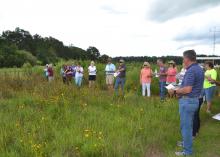Information Possibly Outdated
The information presented on this page was originally released on July 20, 2017. It may not be outdated, but please search our site for more current information. If you plan to quote or reference this information in a publication, please check with the Extension specialist or author before proceeding.
Wildflower project tests best growing methods
NEWTON, Miss. -- Travelers on Mississippi highways and interstates may have noticed colorful stands of native wildflowers planted in various sites for the last two years.
Part of the Wildflower Trails of Mississippi project, these patches of flowers and grasses serve as testing areas for roadside plantings that project coordinators hope will attract tourists and provide colorful habitat for pollinators for years to come. Initiated in 2015, the project is coordinated by Keep Mississippi Beautiful and supported by Mississippi State University and several state agencies.
"Right now, we are still in the observational stage of the project," said Brett Rushing, an assistant professor with the MSU Extension Service and Mississippi Agricultural and Forestry Experiment Station. “We’ve planted several sites using various methods. This growing season has allowed us to observe which planting and maintenance methods work best.”
Rushing, who focuses on native grasses and conservation crops, provided his expertise in choosing the right species to plant and developing maintenance plans for the sites. After evaluating native wildflowers and grasses, Rushing developed a seed blend that performs well in Mississippi’s climate. Rushing planted 12 of the sites, and affiliates planted the other sites.
“We’ve learned a lot so far,” said Rushing, who is based at the MSU Coastal Plain Branch Experiment Station in Newton. “It is important that we have sites to look at and learn from that were planted and maintained by other entities because that is the future of the project. It also helps those who want to be a part of the project understand that maintenance is not easy, and each site requires its own management plan.”
Attendees of the July 13 Wildflower Field Day at the Newton station toured the facility’s four test plots, which Rushing uses to determine the best planting and management practices. On one plot, he broadcast seed on top of a prepared seedbed where preexisting vegetation was controlled with herbicides. On another, he planted seed with a no-till drill into a stale seedbed. On the third, he broadcast seed onto a prepared seedbed where preexisting vegetation was not sprayed. Rushing said the fourth plot -- tilled, packed, treated with herbicide and planted with a drill -- has been the most successful.
For landowners and homeowners, Rushing recommends planting a mix of perennial and annual seeds of the most local ecotypes available, so they can become established and reseed each year.
“You want to plant the most local germplasm available,” he said. “We’ve found that applying fertilizer doesn’t do much for the flowers’ performance, but it does help the grass grow, which will easily outcompete the flowers.”
John Seymour, who founded Roundstone Native Seed with his family, talked about native seed selection and propagation. Rushing worked with Seymour to obtain the seed for the mix used to plant the project sites. Roundstone works with various sources to gather seed, which come from private lands, roadsides, federal lands, heritage properties, national forests and other sites.
“Propagating wildflower seed is a very orchestrated process,” Seymour said.
Depending on the amount of work involved in growing, harvesting and processing, seed varieties can cost from $12 to $300 per pound.
Sarah Kountouris, executive director of Keep Mississippi Beautiful, said the project has gotten a lot of attention.
“We have had a wonderful response to it,” she said. “I get three to four calls a week about the wildflowers. There is so much interest in it, from young people to senior citizens.”
Partners in the project are the Extension Service, Experiment Station, Mississippi Department of Transportation, Mississippi Association of Conservation Districts, Mississippi Department of Agriculture and Commerce, Mississippi Soil and Water Conservation Commission, Natural Resources Conservation Service, Garden Clubs of Mississippi and U.S. Department of Agriculture. Participating cities include Hattiesburg, Winona, Tupelo, Ridgeland, Cleveland, Raymond, Magee, Mendenhall, Clinton, Crystal Springs and Madison.
Field day attendees also heard presentations on building a backyard habitat and research aimed at determining the impact of herbicides and mowing on green antelope horn milkweed growing on roadsides.







